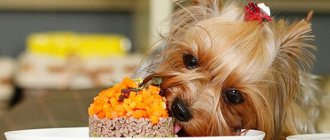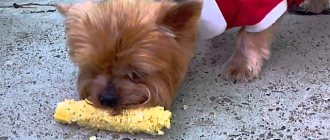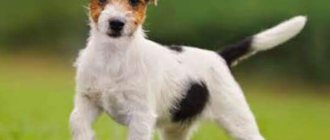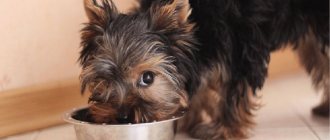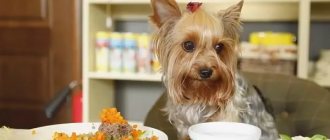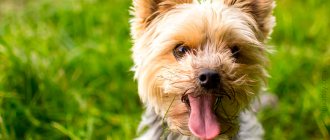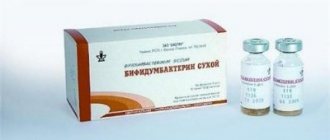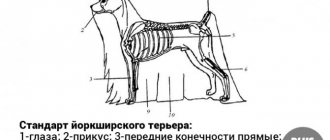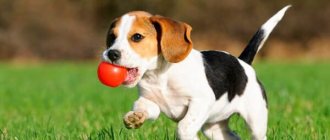Yorkshire terriers are decorative dogs with a lot of positive qualities, thanks to which they have become so popular all over the world.
Yorkies require special care, and this requirement applies not only to adult dogs, but also to puppies.
It is important to understand how the normal development of puppies should proceed, what the weight of the babies should be and when they should be vaccinated, because all these factors are the key to good health and longevity of the dog.
This and much more will be discussed in the article - you will learn how Yorkie puppies develop, how many months they grow and what they need to grow into healthy dogs.. Also here you will find photos with puppies of different ages.
What do newborn Yorkies look like?
Newborn Yorkshire Terrier puppies are born with a smooth black coat and red tan. Their appearance resembles miniature Rottweilers.
A newborn Yorkie has no teeth and his eyes and ears are closed, which means he does not see or hear anything and is guided only by smell.
The size and weight of the puppies depends on whether they are standard or mini Yorkshire Terriers. On average, at birth, puppies weigh from 80 to 160 grams.
Pros and cons of Yorkies
Miniature dogs are very good companions when traveling and visiting various kinds of events. They fit very compactly into a handbag and, due to their rather flexible nature, can withstand almost all the hardships of carrying. However, in order to own a Yorkshire Terrier, you need to become familiar with the advantages and disadvantages of the breed. Not the least important thing to choose from is the information up to what age Yorkie puppies grow.
So, the obvious advantages of dogs include:
- Dogs take up little space and can even be carried in the cabin of an airplane.
- Almost all Yorkies (especially girls) get along well with other dogs.
- In case of bad weather or other reasons, the Yorkshire Terrier can relieve itself on a diaper or cloth.
- With a fairly high cost, doggies require fairly low costs in terms of food and treatment.
- Yorkies are very suitable for allergy sufferers, since they have no undercoat at all and the hair structure is similar to human hair.
Of course, like their other relatives, terriers also have some disadvantages:
- Dogs have a well-developed hunting instinct, thanks to which Yorkies can chase squirrels or cats.
- An active dog is not suitable for calm or elderly people.
- Boys of this breed mark their territory more abundantly than other dogs.
- Beautiful coat requires careful and frequent care.
Growth and development
2-3 days after birth, puppies begin to crawl. At 10-15 days their eyes open, the puppies begin to respond to light, but the retina is still poorly developed.
By 18-21 days, Yorkie babies develop a fat layer, thermoregulation appears, and they begin to respond to sharp sounds.
On days 20-24, teeth begin to erupt, and by this age the puppy begins to hear.
By the month the puppies' activity increases, they leave their “playpen” and get acquainted with their surroundings.
At 8-9 months, the change of teeth ends, and the dog begins puberty. By this age, the Yorkshire Terrier reaches its maximum height, but is still developing.
In the first months of life, puppies develop as intensively as possible; it is important to monitor weight gain in order to understand that the puppy is eating correctly and is not underweight or overweight.
Yorkie puppies weight table by month:
| Age | Micro | Mini | Standard |
| Birth weight | 80 gr | 115 gr | 160 gr |
| 1 month | 230 gr | 370 gr | 595 g |
| 2 months | 370 gr | 610 gr | 940 gr |
| 3 months | 540 gr | 850 gr | 1280 gr |
| 4 months | 710 gr | 1110 gr | 1680 g |
| 5 months | 850 gr | 1300 gr | 1990 gr |
| 6 months | 940 gr | 1450 gr | 2210 gr |
| 18 months | 1140 gr | 1820 gr | 2730 gr |
As adults, standard Yorkshire terriers reach a height at the withers of 22-24 cm, mini - 16-18 cm, micro - up to 15 cm.
Dimensions and proportions of a Yorkie in accordance with the standard
The standard for this breed FCI No. 86 dated January 20, 1998 determines not only how much an adult dog should weigh and what its height at the withers should be, but also regulates the proportions of the animal: the position of the tail, paws, the shape of the skull and muzzle. Normally, the dog has a compact square body, a neck and muzzle of moderate length, a small and flattened head without roundness or significant protrusions.
The tail is usually docked to medium length and is held high by the dog, above the level of the back. The front and hind legs are straight. Limbs that are too short or long, as well as deviations from the norm in other parts of the body, are not allowed by the standard.
Types of puppies
A litter born from two standard representatives of the breed may produce standard puppies or the so-called mini, super-mini and baby-face Yorkies, which differ from the standard ones in weight and have a shorter muzzle with an upturned nose.
Also, puppies can belong to such varieties of Yorkshire terriers as Russian Saloon, Goldust, Chocolate or Biro, but this can only happen as a result of targeted breeding work .
Vices of non-standard dogs
Representatives of the breed that do not meet the standard have a lot of health problems. Hence, Yorkies that are too small in weight are most often observed:
- Hypoglycemia.
- Drowsiness, lethargy, loss of coordination of movements caused by hypoglycemic shock.
- Digestive problems.
- Paradontosis.
- High probability of fractures.
- Joint diseases.
- Patella dislocation.
- Tracheal collapse.
- Ear infections.
- Cryptorchidism.
- Not overgrown fontanel.
- Legg-Calvé-Perthes syndrome.
- Intolerance to anesthesia.
Also, female mini or micro Yorkies cannot reproduce - they cannot bear and give birth to healthy puppies on their own. To obtain small cubs, standard females are mated with small males. The structural features of the baby Yorkie's face are the cause of chronic conjunctivitis (due to a narrow tear duct and frequent eye injuries) and breathing problems, due to which the dog can “grunt” when moving and snore.
The life expectancy of non-standard representatives of the breed is much lower: 10 - 12 and 7 - 9 years for mini and super mini Yorkies, respectively.
How to care?
During the first weeks of life, the puppies are looked after by a bitch - she feeds them, turns them over, and constantly licks them. The breeder must only ensure that the puppies do not become hypothermic or overheated, and that the bitch does not accidentally crush them.
On the 3-5th day, they need to remove the dewclaws, if any - you need to stretch the skin on the puppy’s paw and quickly cut off the extra toe with sharp office scissors, and then cauterize the wound with potassium permanganate.
Around the 5th-6th day, you need to trim the nails so that they do not hurt each other or the belly and nipples of the bitch during feeding.
Puppies should not be bathed until they are 3 months old, but they must examine their eyes daily and wipe them with chamomile infusion or a special lotion.
At about a month, when the coat is quite long, the puppies need to have a hygienic haircut - use a special clipper to trim the hair in the groin area, near the genitals and anus. It is also necessary to free the upper third of the ears from fur so that they do not bend under its weight and acquire the vertical position required by the breed standard.
At the same age, you should begin raising puppies, accustoming them to a diaper or tray.
When the Yorkshire Terrier grows up and is vaccinated, he should be walked every day - this is necessary not only for the physical health of an active and energetic dog, but also for its socialization and the formation of a stable psyche.
After each walk, you need to thoroughly wash your paws and belly, and give your pet a full bath about once every 3 weeks.
You should also brush your dog daily to prevent its fur from getting tangled, and monitor the condition of its teeth, mouth, and ears.
Possible complications
In most cases, the Yorkshire Terrier gives birth without complications. Problems arise if the bitch has a narrow pelvis and cannot give birth on her own. In this case, a caesarean section is required. A sign of the need for surgery is dirty gray discharge that appears shortly before birth. It is also important to ensure that all secondary births occur during delivery - their number should be equal to the number of puppies. Placentas that are not expelled during birth may be expelled within 24 hours afterward; if this does not happen, the dog must be taken to the veterinarian.
First vaccinations
Mother's milk protects newborn puppies from infections and diseases. When the feeding period ends, this protection disappears and is replaced by immunity developed by the puppies on their own.
Vaccinations are required to develop the immune system.
Any vaccination has several basic rules:
- It is prohibited to vaccinate a pregnant or lactating bitch;
- You should not vaccinate too early, otherwise it will not work and the risk of infection will increase;
- the same drug should be used for vaccination and revaccination;
- the puppy must be completely healthy.
In addition, 7-10 days before vaccination it is necessary to carry out deworming, and the dog cannot be bathed a day before the procedure.
The standard vaccination schedule includes vaccinations against rabies, hepatitis, parvovirus gastroenteritis, distemper and leptospirosis.
Vaccination schedule:
- 1st vaccination – 8-9 weeks;
- revaccination – 10-11 weeks;
- 3rd vaccination – after changing teeth, approximately 7.5-8 months;
- rabies vaccination – 3-4 months and a year.
In the future, the Yorkshire Terrier must be vaccinated annually at the same time.
The owner chooses the vaccine for vaccination himself (usually Eurikan or Nobivak), and notes on the vaccinations performed are made in the veterinary passport.
A slight increase in temperature and refusal to eat after vaccination is a normal reaction of the body.
What influences the development of an animal
Yorkies are small dogs. Their height and weight, as well as their further development, are influenced by genetic factors. Sometimes a standard mate is used to produce small pups for mating, with the male being smaller than the female.
Various factors can influence the development of dogs
For your information! Female mini-Yorks are not used for breeding due to their inability to bear and give birth normally.
In addition to genetics, there are many other negative factors that affect the development of dogs:
- poor quality food;
- excess nutrition for children;
- poor living conditions;
- lack of essential vitamins and minerals;
- diet violation;
- use to reward a large number of unacceptable treats;
- helminthic infection;
- long-term infectious diseases;
- poor health from birth;
- increased calorie intake with low energy expenditure;
- disruption of the endocrine system;
- pathology of the liver and cardiovascular system.
Note! The development of puppies can also be affected by certain body structure features and imbalances in proportions. The life expectancy of individuals with non-standard sizes is less than that of dogs that meet all standards.
How to bathe properly?
Before bathing your puppy in the bathtub or sink, you need to lay a rubberized mat so that the pet does not slip. You should use shampoo and conditioner that is appropriate for your coat type and will make it easier to comb, and the water should be at room temperature.
The shampoo should be rubbed in your palms, mixed with water, lathered on the dog and rinsed off, repeating all this twice. Then apply conditioner, leave it on the coat for 2-3 minutes and rinse.
When bathing, you need to make sure that water does not get into your Yorkie's ears - it is better to cover them with cotton swabs.
After bathing, wrap your pet in a towel, then dry the coat with a hairdryer and comb it.
You can bathe the puppy only after a two-week quarantine has passed after the 2nd vaccination, i.e. at about three months of age.
What to feed a Yorkshire Terrier puppy in the first 2 months of life
Puppies open their eyes at the age of a week or one and a half, and then they begin to hear. They can lap from the age of 2-3 weeks , at which time additional food can be introduced , since the mother’s milk may not be enough, and the puppies grow very quickly.
To do this, milk porridge first introduced into the terriers' diet .
When the pet is one month old, they begin to give : lean, finely chopped beef or chicken, eggs, cottage cheese, kefir, boiled vegetables (carrots, beets), water porridge, apples, pumpkin seeds.
At 2 months old, a Yorkie can be given dry food , which must be selected by a veterinarian for this breed, as allergic reactions are possible.
Once the puppies are a month old, you can carefully trim their nails.
Advice! It is also important to maintain the temperature regime (24 - 26 degrees), not to create drafts or heat in the apartment. You need to wipe your Yorkie's eyes with a cotton swab and examine them every morning.
Changing and brushing teeth
The change of teeth from milk teeth to molars in Yorkies begins at 3.5-4 months and should be completely completed by 8-9 months, maximum by 1 year.
During this period, the puppy should be given toys that are easy to chew and special treats to help the teeth loosen faster.
Due to the special arrangement of teeth, food debris often accumulates between them, which needs to be cleaned out with a toothpick.
In addition, Yorkshire terriers are prone to plaque and the formation of stones, so you need to brush your pet’s teeth 2-3 times a week with a special paste and brush sold in pet stores, and conduct a thorough cleaning at the veterinary clinic twice a year.
Care and maintenance
Before you bring a puppy into the house and start caring for him, you need to prepare the apartment for the arrival of a new friend and purchase the necessary things. Remove everything from the floor that a curious dog could chew on, hide the wires and, for a while, give up carpets: the dog is not yet toilet trained and may cause mischief.
A little Yorkie may be frightened by a new environment. You need to give him time to get comfortable and get used to you.
List of things you need when your pet arrives in your home:
- aviary or bed;
- two bowls for water and food;
- toys: rubber balls, squeakers and bones made from veins;
- hair care products;
- comb, hairpins and elastic bands;
- scissors and nail file;
- bag - carrying.
Over time, you will need to buy clothes for walking and a collar with a leash. You need to take your puppy outside gradually. To begin with, short walks of 15–20 minutes in a quiet and peaceful place, while the dog should be held in your arms. When the baby grows up and gets comfortable, you can walk him on a leash twice a day.
When is weaning from the mother?
You need to take into account the condition of the bitch and the behavior of the puppies - when the puppies are cutting teeth and growing claws, the bitch may experience unpleasant and painful sensations during feeding. This indicates that it is time to wean the puppies.
Most often, puppies are separated from their mother when they are 50-60 days old. Moreover, if the bitch has problems with lactation and there is not enough milk, this can be done at 3 weeks.
Starting to raise a Mini Yorkie puppy
Usually babies go to new owners from a breeder at the age of 2-3 months, without having the skills to carry out the owner’s commands. In the first months of a baby’s life without a mother, patience, perseverance and affection are needed in upbringing.
You cannot shout at the animal or raise your hand . You need to affectionately ask to give a paw, sit or lie down, and if the command is successfully completed, reinforce the knowledge with a treat.
Yorkie will quickly understand when he can get a tasty snack and will try. If the child does something wrong, speak in a stern tone, but calm, without aggression.
Important! Learn commands with your pet such as “Ugh!”, “No!”, “Place”, “Nearby” - this is the minimum required for future walks with the dog. Since all dogs love to pick up anything they miss from the asphalt, it is important to teach the puppy these commands.
How to choose a puppy?
First of all, you need to choose a trusted nursery and conscientious breeders - this will minimize the risk of buying an unhealthy puppy. In the kennel, you need to pay attention to the living conditions of the dogs, find out about the puppy’s parents and their health. The breeder must answer all questions and present all necessary documents.
A healthy puppy should be active, friendly and curious, be able to feed itself, and have:
- black, cold and wet nose;
- dark eyes, without discharge and increased lacrimation;
- the stomach is not bloated;
- the coat is soft, thick and shiny, without bald spots;
- skin without peeling, rashes or signs of irritation;
- each jaw has 2 canines and 6 incisors, scissor bite.
The puppy must also have a veterinary passport with deworming and vaccination records.
Diseases and treatment of a puppy from 1 to 8 weeks
Mom will still do most of the care for her puppies until they are fully weaned at five to seven weeks of age.
However, her puppies will become less and less dependent on her after three to four weeks of age. You may find the puppies crawling out of their little “nest” and trying to explore the house more. It is best to keep mom and puppies in a pen for exercise when you are not home.
The first few weeks of life are a vulnerable time for puppies. If the puppy is not growing at the same rate as his littermates, he should be seen by a veterinarian as soon as possible. In addition, you should take any signs of illness seriously, even if they are subtle.
Useful video
In the video, the breeder explains how to choose a Yorkshire Terrier puppy:
The period of development of a puppy is divided into four stages 1) Prenatal (prenatal) period “Intrauterine memory” is preserved for the mother’s diet, stressful situations 2) Neonatal (“vegetative phase”) - from the moment of birth until the opening of the eyes 3) Transitional (“awakening phase” ) from the opening of the eyes to the opening of the ear canal 4) Young animals from 8 months to 2 years
Puppy development calendar
small energy reserve (no fat layer), physiological weight loss (10%), excretion of meconium (original feces)
1-5 pain sensitivity is reduced, the brain is poorly developed
beginning of coloring of the nose
deafness and blindness, but developed sense of smell, touch, taste, crowding reaction
reacts to touch, source of heat, squeaks when something bothers him, alternates between sleeping and sucking (no day-night separation), does not urinate or poop on his own
period of socialization (the mother begins their adaptation to adulthood with the help of facial expressions and some aggressive actions)
increased motor activity, formation of daily rhythm respond to the nickname
certification and branding, accustoming to hygiene procedures (combing, cleaning ears, examining teeth)
the best assimilation of new information (learning commands), the desire to learn about surrounding objects (gnaw, grab, chew)
human communication is necessary, do not keep in a cage around the clock (this leads to developmental delays)
beginning of accustoming to car trips, urban environment,
finding one’s place in a team (among dogs and people), the first beginnings of leadership
puberty, males begin to raise their paws, mark their territory
do not force one to approach the object one is afraid of, trusting relationship
it is necessary to pull out lost fangs, rabies vaccination
Yorkies (Yorkshire terriers) are a breed of decorative dogs whose homeland is Yorkshire (Great Britain). Externally, these dogs are distinguished by their miniature size and interesting fur structure - reminiscent of human hair. Yorkies are distinguished by their good-natured, playful character and devotion to their owners. These are wonderful pets for people living in an apartment, because such dogs are “room”, “tame” dogs.
The problem of obesity and how to lose weight
If your dog is not fed correctly, it may be overweight. Yorkies are prone to obesity if they are overfed and do not get enough exercise.
Excess weight often causes the development of serious diseases (diabetes, etc.), problems with joints and breathing, liver diseases and high blood pressure. Excess weight negatively affects appearance and longevity.
Obesity can be eliminated with strict adherence to the diet and a properly selected diet. All necessary substances must be present in food.
Important! Serving size and calorie content should be appropriate for the dog's energy expenditure. The diet should be based on the age and size of the animal.
It is important that Yorkies are given the necessary physical activity, this will allow the dog to expend more energy and maintain normal physical condition.
Knowing at what age Yorkshire terriers grow up, you should choose the necessary diet in time and monitor the physical condition of the dog.
The weight of an adult dog depends on proper maintenance
Weight and height of puppies
The breed characteristics do not indicate the average height of a Yorkie. On average, doggies grow to 15-22 cm at the withers. Normal weight: 1.3-3 kg. The normal weight of large individuals is 3.6-4 kg.
The standard weight for puppies varies depending on the breed type they are: dwarf, small, medium or large. The height at the withers is also ranked according to these types: mini - no more than 15 cm, medium group - 15-18 cm, large representatives - 16-22 cm.
Average indicators for the breed are in the following table.
| Days | Physiological development | Behavioral changes | Actions of the breeder (owner) |
| 1 | arrangement of a warm box, in a semi-dark place | ||
| 4 | begins to find the milkiest nipples, knows the smell of the mother | make sure the bitch doesn't crush the puppies | |
| 1-5 | 3-5 day dewclaw removal, tail docking | ||
| 5 | |||
| 1-30 | lack of thermoregulation | ||
| 1-10 | 8 feedings, provide semi-darkness and a warm place | ||
| 10-15 | open their eyes | crawls without standing on its feet | minimum brightness of light in the room |
| 13 | the pupil reacts to light, the retina is poorly developed | ||
| 16-18 | begins to stand on its paws, swaying from side to side | ||
| 18-21 | formation of adipose tissue, there is thermoregulation | starts wagging its tail | |
| 20 | flinch reaction to a sharp sound | ||
| 21-24 | beginning of teething, hears | reaction to noise, first games between puppies | |
| 21-50 | |||
| 22 | manifestation of interest in meat, the beginning of the extinction of the sucking reflex | ability to chew, bite | |
| 21-28 | transition from breastfeeding to mixed feeding | the beginning of understanding the world, learning to drink water | need a calm environment |
| 28 | 1 dewormer | ||
| 30 | presence of teeth: canines, incisors, first and second false roots | exit from the lair | moving from a cage to an enclosure, training to a tray |
| 35 | body temperature of an adult dog | from 1 to 2 months weighing every 5 days | |
| 45 | |||
| 48-53 | the nervous system is formed | ||
| 55-85 | period of fear, final transition to food | avoid psychologically traumatic factors | |
| 56 | 2 dewormer | ||
| 58 | starts barking | 1 comprehensive vaccination, diversify the environment surrounding the puppy | |
| 60 | presence of all primary teeth | ||
| 84 | 3 dewormer | ||
| 86 | 2 complex vaccination | ||
| 90 | fully ready for independent living, socialized, vaccinated twice | start taking people out for walks | |
| 12 weeks | formation of individual character traits | ||
| 13-16 weeks | |||
| 4-8 months | desire to run away from the owner, “sexy” games | ||
| 7-8 months | end of growth, female follicles are ready for ovulation | 6 months – 3 dewormings | |
| 6-10 months | first heat | fear of new situations | |
| 8-9 months | final change of teeth – 42 permanent teeth |
| Age (months) | Approximate weight (kg) |
| Newborns | 0,09-0,1 |
| 1 | 0,3-0,5 |
| 2 | 0,4-0,9 |
| 3 | 0,6-1,3 |
| 4 | 0,8-1,7 |
| 5 | 1-2 |
| 6 | 1,1-2,5 |
| 7-12 | 1,3-3,4 |
The formula will help you calculate the weight of a puppy in the future: weight at 2 months (8 weeks) * 3. The resulting number is the approximate weight of the Yorkie upon reaching 1 year. To weigh a miniature dog, you can use a regular kitchen or floor scale.
Both excess weight and body weight dystrophy are harmful to Yorkies. If a young animal is already obese, the risk of injury, development of joint pathologies, and hypoglycemia increases. Common problems with “severe” Yorkies: luxating kneecaps, hip dysplasia.
Weight loss may indicate helminth infection, congenital pathologies, or hormonal diseases that inhibit development. A common cause is improper, insufficient feeding. If a one-year-old Yorkie weighs less than 1.3 kg, a veterinarian examination is required.
What to do if the puppy is behind the norm
Owners often fear that the puppy will not reach the required weight and size by a certain age. In this case, you should not immediately worry and worry; the standard indicators in most cases are average.
All dogs are individuals and develop differently; by one and a half years they usually reach normal weight and size.
Note! Children often do not eat well when their teeth change.
The owner advises to carefully review the child’s diet; it may be worth adding the necessary vitamins and minerals. It is important that the food contains enough fats, proteins and carbohydrates. You should choose it based on the age of the dog and give preference to a quality product. However, it is also prohibited to overfeed the puppy, which can lead to obesity.
It is necessary to carry out anthelmintic prophylaxis in a timely manner, because parasites can also cause a deficiency of the required weight.
If the problem is critical, it is recommended to visit a veterinarian. You may need to get tested and find suitable treatment. It is important to promptly examine the baby for the presence of serious infectious diseases that can cause disruptions in the digestive system and weight loss.
it is important to provide Yorkies with quality physical activity
Development of puppies by month
Newborn puppies are deaf and blind. They practically do not move: they sleep most of the day, the rest of the time they eat. The dogs are completely dependent on their mother - they feed on her milk and keep warm. She takes full care of their hygiene.
In order not to frighten the dog's family, a person should not pick up newborn babies or stroke them. Communication with puppies begins when they begin to see and hear and are ready to explore the world.
Photos and videos of a newborn Yorkie:
1 month
Almost immediately after birth, Yorkies have their tails docked. By the first month of life, the wound heals. At this age (10-14 days), the dogs’ eyes are already appearing and their ears are opening. Month-old puppies tend to explore their surroundings. The owner needs to make his home as safe as possible - it’s easy for a miniature puppy to get injured.
The baby gains weight rapidly - by 4 weeks it almost triples. A one-month-old puppy stops crawling funny - he can walk, and tries to run clumsily. Becomes very active - communicates with people and brothers. He is gradually weaned from his mother's milk: he is given liquid, and then softened and solid complementary foods.
Photos and videos of Yorkie 1 month:
2 months
At this age, puppies are already completely independent from their mother and go to live in a new home. The animal is ready for upbringing and socialization: the puppy is explained the rules for walking, communicating with people, and behavior in the house. For wrongdoing they reproach, ignore, and for good behavior they reward with “yummy food” and affection.
The dog is already eating solid food. It can be smoothly transferred to a new diet, different from the food in the breeder’s house: from food to natural food or vice versa. It is important to make the transition gradually to avoid digestive upset.
Photos and videos of Yorkie 2 months:
3-6 months
The little Yorkshire terrier continues to actively explore the world, learning to coexist with people and other animals. It is important for the owner to pay attention to his socialization - at this stage the dog’s character and his habits are established. Miniature and cute Yorkies can be stubborn and wayward: only education will make them obedient and kind pets.
An important physiological change: the babies' ears begin to straighten (one of the characteristics of the breed). This process does not have clear deadlines - there is nothing to worry about if it drags on.
From about 4 months, baby teeth are replaced by permanent ones: first the front ones, then the canines and molars. Just like in humans, this process is unpleasant and painful: the puppy may become capricious, lose appetite, and fall into apathy.
Photos and videos of a 3 month old Yorkie:
Photos and videos of a 4 month old Yorkie:
6-9 months
The puppy ceases to be a “child”. Translated into human standards, he enters “adolescence” with all its problems: demonstration of willfulness, stubbornness, desire to master the whole world and get to know its inhabitants. Patience is required from the baby's owner: you cannot frighten, beat, or punish the animal. This approach will “give” a timid, aggressive, distrustful Yorkie.
But the dog is always shown that the owner is dissatisfied with his faults and pranks: the person speaks in a stern tone, refuses to play and pet him for a while. Bad behavior is also associated with puberty: Yorkie girls experience their first heat.
At this time, females are sterilized if the owner does not plan to breed. It is important not to delay the operation: delay threatens the further development of breast and ovarian cancer.
Video of Yorkie 8 months:
9-12 months
The puppy becomes an adult animal: growth slows down, weight gain slows down. He is transferred to food for adult Yorkies, and the frequency of meals is reduced strictly to 1-2 times a day.
Yorkies live, on average, up to 10-12 years. However, they are considered senior dogs from 8 years of age. At this age, the owner must change the food according to the veterinarian’s prescription and provide the dog with the necessary living conditions.
Photo of Yorkie 1 year:
Features of keeping Yorkies
Yorkshire terriers have become popular pets due to the lack of undercoat - this frees the animal from seasonal shedding. Dogs only have guard hairs, which makes them look like humans. Yorkie's coat is hypoallergenic, but a person may be allergic to the animal's saliva, sweat, or excrement. If the hairs begin to fall out, this is an alarming sign: the dog may be sick.
The fur must be combed and trimmed so that it does not cover the eyes or get into the mouth. Owners use the services of grooming salons, where their pet can receive not only a hygienic, but also a decorative haircut and styling. Some owners put their bangs in a ponytail so that they do not interfere with the baby.
After mother's milk, the puppy is recommended soups, liquid semolina, and buckwheat porridge. They can be sweetened a little with honey. Raw yolk is also beneficial for a young Yorkie. A one-month-old puppy is fed 6 times a day, but by the age of one year the number of meals is gradually reduced to 1-2.
Already at 1 month, the dog is offered small pieces of lean beef, veal, calcined cottage cheese soaked in milk. To meat dishes, add a side dish of mashed boiled vegetables (beets or carrots), sprinkle them with chopped herbs.
By 3 months, the food is slightly flavored with vegetable oil or fish oil. In addition to veal, your Yorkie can be given offal: dogs love chicken liver and gizzard. They give you fruit to try: if you like the delicacy, pureed pieces of apple and soaked dried fruit are mixed into the porridge. From 4 months, the animal can be treated to peeled, chopped walnuts.
